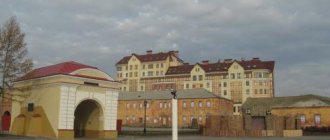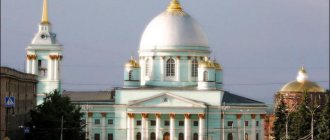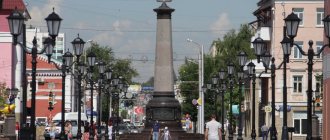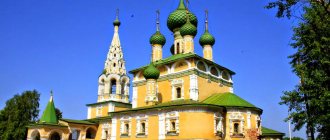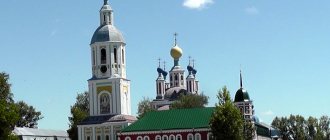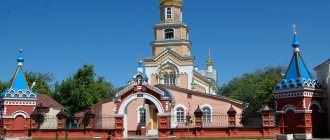By Russian standards, the city of Omsk is very young, it is only 303 years old. However, it is one of the largest cities in Russia with a population of more than one million people. Omsk has an airport, all types of ground transport, a seaport, 28 higher educational institutions, 14 theaters, a huge sports arena and amazing architecture. The preservation of historical and cultural heritage, as well as the increase in the level of architectural and artistic expressiveness of the city, is monitored by the Omsk Department of Architecture. This is understandable, because the city has more than five hundred cultural heritage sites!
History of the first constructions
The year of foundation of Omsk is considered to be 1714. Of course, before the construction of the main objects, namely the Omsk fortress, began, people already lived on the territory of the city, as on any land near large rivers rich in fish, such as the Irtysh and Om. It is near these watery geographical features that archaeologists to this day find traces of the presence of ancient settlers of the 6th millennium BC. e. to XIII century AD e.
However, Peter I began serious development of the Siberian land to strengthen Russian borders in the east, as well as scientific research and the search for “sand gold”.
Colonel Ivan Buchgolts received the tsar's order to build a fortress on the Om River, leave a garrison there and move on with the expedition. So in 1716 the first fortress was founded in the city of Omsk. The fortress had four gates: Omsk, Tara, Tobolsk and Irtysh. The Tobolsk Gate has survived to this day, and in 1991 the Tara Gate was restored.
Afterwards the so-called headquarters was built, which has survived to this day. The city gradually grew, and in 1764 the Resurrection Cathedral was erected; it became the first stone building of the city; it would be demolished only in the 20th century. The first architecture of Omsk was being formed. New buildings, general and commandant's houses, barracks, a market and an educational institution were gradually built around the fortress.
Omsk - past and present. presentation for a German lesson on the topic
Slide 1
Local history in German lessons Natalya Anatolyevna Bovenko, German language teacher at Municipal Educational Institution “Secondary School No. 17”
Slide 2
Project participants: Alekseenko Alexandra Bogdan Tatyana Balashova Anastasia.
Slide 3
Goal: To develop in students a patriotic attitude towards their native land. Objectives: Use various sources to obtain the necessary information about the past and present of Omsk. Synthesize the information received into a presentation
Slide 4
Am 18. April wurde OON, ein internationaler Tag der Denkmaler und Hustorischer stellen bestimmt. Fur uns ist es kein schlechter Anlass sich zu erinnern, dass unsere Stadt eine Geschichte von fast drei Jahrhunderten besitzt. Das bedeutet, dass uch hven nicht wenig Orte gibt, die man kennen und bewahren muss.
Slide 6
Das ist der Theaterplatz früher Zu Beginn des Jahrhunderts richtete sich auf dieser Stelle die Polizeibehörde ein, nach der Revolution wurde dieses Gebäude zerstört. Zur sowjetischen Zeit, war diese Stelle des zentralen Teiles der Stadt besonders durch die Holzbauten geschmückt.
Slide 7
Das ist der Theaterplatz heute Ende der siebziger Jahre haben sich die Behörden entschieden, die unansehnliche Fassade dieser Bebauung mit originellem Bau für das Theater der musikalischen Komödie zu ersetzen. Lange Zeit musste sich die Bevölkerung des reifen Alters an diese eigentümliche architektonische Lösung in Form “vom Segel” gewöhnen. So entzifferten die Kenner den gelegten Verfasser-Gedanken. Etwas symbolisches wird in diesem Flug des architektonischen Gedankens gesehen, der in die Realität in 1982 verwirklicht wurde.
Slide 8
Das ist die Kadettenschule früher Die sibirische Kadettenschule (die erste Militärbildungseinrichtung in Sibirien) war zur sowjetischen Zeit das höchste und wichtigste militärische Bildungseinrichtung namens Frunse. Sacharow Andrejan Dmitrijewitsch (1761-1811), der russische Architekt, der Schöpfer eines der Meisterwerke der russischen Architektur. Er war auch der Schöpfer der Kadettenschule.
Slide 9
Das ist die Kadettenschule heute Im Frühling 1999 wurde die Kommandobildungseinrichtung geschlossen. Ende August 1999 hat eine feierliche Wiedereröffnung der Kadettenschule stattgefunden.
Slide 10
Das ist das Museum der darstellenden Künste im Namen. M.Wrubels früher Der Generalgouverneurspalast hat, im Unterschied zu anderen Gebäuden in Omsk der zweiten Hälfte des 19 Jahrhunderts, in vieler Hinsicht die äußerliche Gestalt und das Planieren erhalten. Der Bau verwirklichte sich unter Leitung "Architekt FFWagner" und Ingenieur KJLasarewas. In 1862 war der Bau fertig.
Slide 11
Das ist das Museum der darstellenden Künste im Namen. M.Wrubels heute Der Palast hat auf dem Jahrhundert viel Ereignisse erlebt und hat nicht wenig Veränderungen erprobt. Ab 1985 nimmt das Gebäude des ehemaligen Generalgouverneurspalastes folgenden Namen ein «das Museum der darstellenden Künste im Namen. M.Wrubels.” Heute be suchen viele Menschen das Museum, um sich dort unter anderem die schönen Gemälde anzuschauen.
Slide 12
Das ist das Tarski Tor früher In 1959 wurden "Tarskije Vorota", laut der Verfügung des städtischen Leiters Koluschtschinski jener Zeit, abgerissen.
Slide 13
Das ist das Tarski Tor heute In 1991 war das Tor auf der vorigen Stelle neu aufgebaut. Mit jener Zeit hat die neue Etappe der Wiederherstellung der historischen Gestalt des zentralen Teiles der Stadt angefangen.
Slide 15
Analysis of survey results
Slide 16
Diagram
City architecture
Omsk is located on the Irtysh and Om rivers. Like all cities of that time, it was made of wood. Since 1826, there has been a series of fires that almost completely destroyed the city. From that time on, a new architectural life in Omsk began. The architect V. Geste was sent here from St. Petersburg to create a new and modern city. At that time, a palace was built for the governor, gardens, a commercial school, a Siberian cadet corps and the first street lighting appeared.
The houses along the river belonged mainly to wealthy citizens and were built of stone, while the rest of the buildings remained wooden. After the arrival of the railway in 1894, the city began to develop rapidly.
Subsequently, the city was built like an amphitheater: low buildings in the center, and the further from it, the height of the buildings increased. Behind the historical part of the city, 20-30-story buildings have risen. Now the Department of Architecture and Urban Planning of Omsk is solving problems with the restoration of a number of historical monuments that are in a decadent state. Many wooden monuments were destroyed in the 90s with the development of private business. Now the architecture of old Omsk requires very serious reconstruction, and it is often easier to completely destroy it than to preserve it.
Historical monuments of the city
Of the monuments that were preserved, the most important are:
- Omsk fortress, built in 1716.
- The Tobolsk Gate, which belongs to the fortress, also represents the cultural value of the city. This gate led to the fortress where the convict prison was located. Now the gate is a symbol of the city.
- In 1862, the architect F. F. Wagner designed the Governor General's Palace in the city center on the banks of the Om River. The palace has survived to this day almost in its original form.
- In 1813, a Cossack school was built, which was later renamed the Siberian Cadet Corps; the building has survived to this day.
- The mansion of the merchant Batyushkin is an incredibly beautiful stone building. An amazing architectural ensemble, devoid of clear symmetry. It was erected in 1902.
- Another unusual decoration of Omsk is the fire tower. Built on the site of a wooden predecessor, it was often threatened with demolition, but ultimately remained intact to this day.
Architecture of Omsk - from the 17th century to the Soviet period
Content
17th century in Omsk architecture
The architecture of Omsk dates back to 1716, when the detachment of Ivan Buholts landed on the Om River and built two small redoubts. This became the starting point in the formation of the city and its architecture.
The style picture of architectural Omsk is multifaceted and varied. The first explorers of Siberia, immigrants from the northeastern districts of Russia, brought here their carpentry skills and the ability to use wood as the main building material. At first they built small huts. Then the construction of five-walled huts or a house of two huts with a passage through the vestibule developed. Similar monuments of wooden architecture of Omsk architecture can be found in a number of villages in the Omsk region - in the Bolsherechensky, Gorky, Muromtsevo districts, wooden buildings from the late 18th - early 19th centuries are still preserved.
With the development of brick production in the mid-18th century, stone construction began to develop in Omsk; At the same time, the construction of the Spassky Church began in Tara in 1755.
Spasskaya Church in Tara, Omsk Region
The religious buildings of Omsk did not differ in great architectural diversity - few of the craftsmen who built the churches carried over the features of the previous building from temple to temple. But, using a creative streak, you can still find some original elements in almost every building of that time.
The Spasskaya Church has become the clearest example of Siberian Baroque in the Omsk Irtysh region - it has a three-part “ship” composition and two floors, the first of which ends with a vaulted ceiling.
Directly in Omsk, the first stone structure was the building of the fortress Resurrection Cathedral (begun in 1754).
Resurrection Cathedral Omsk 1754
Architect Ivan Cherepanov, sent from Tobolsk for this construction, discovered a discrepancy in the project with church rules - the altar of the cathedral was facing south, not east. This error has been fixed. Subsequently, his brother, Kozma Cherepanov, was involved in the completion of the cathedral.
By the end of the 18th century, intensive stone construction of Omsk with administrative and residential buildings began. More active construction from brick and stone continued in Omsk in the 19th century.
Lutheran Church Omsk 1792
In 1792, a Lutheran church was built in the eastern part of the Omsk fortress - a one-story building with a semicircular apse on the eastern side. The building has survived to this day. The decor of the church is made in the Baroque style.
Architecture of Omsk in the 19th century
Many buildings in Omsk, built during this period, are historical and architectural monuments. Such buildings include the building of the former guardhouse.
Construction of the guardhouse began in 1781. During this period, classicism was already gaining popularity, but Baroque features were still noticeable in the design of the building - in the cornices above the windows and in the turret that crowned the building. And in the simplicity and severity of the finished guardhouse, a new style is already visible.
A typical example of classicism is the building of the Siberian Cadet Corps (1826).
Siberian Cadet Corps
Built according to an exemplary design, it absorbed the architectural features characteristic of that period - a strict silhouette and a minimum of details.
The style direction of the building was then repeated during the construction of the Cossack St. Nicholas, or Holy Cross Cathedral (1833-1840), built according to the drawings of the outstanding architect of that time V.P. Stasov. Its architecture reflected the interest of the architects of that time in historical styles - the silhouettes of the domes and bell tower are reminiscent of baroque buildings.
One of the first city-wide buildings in 19th-century architecture in Omsk was the Military Assembly building, built from 1858 to 1861. According to historians, the architect of the current House of Officers was F. Wagner. The building in the style of late classicism fit well into the architecture of the city of that period - opposite it stood a wooden wing of the general's house, and across the street - a baroque-style guardhouse.
Mansion of the Kabalkin family (Liberov-Center)
Wooden architecture in Omsk was also preserved during this period - many buildings of that time were richly decorated with intricate carvings, because the house of a Siberian owner should be not only strong, but also beautiful.
20th century in the architecture of Omsk
By 1905, Lyubinsky Avenue was formed in Omsk. In the complex of buildings located on it, the leading place is undoubtedly occupied by the Moscow Rows (architect O. Dessin).
Lyubinsky Avenue itself took shape over two centuries - several stone houses were built along its eastern side. But already in 1903, a representative of manufacturers from Moscow arrived in Omsk, and long brick rows of houses with shops on the first floors were lined up along Lyubinsky Prospect, and in the next two years the entire western side of the avenue was built up.
Omsk Academic Drama Theater 1901-1908
The decoration that completes the street was the Omsk Academic Drama Theater (1901-1908).
The Art Nouveau style in Omsk is represented by the building of a commercial school (1915-1916), located on Partizanskaya Street, which has the status of an urban planning monument of federal significance. One of the decorations of Omsk architecture is the building of the Siberian Railway Administration (1914-1916).
Omsk State Transport University, 1914-1916
Built according to the design of the architect A.I. Dmitriev, its decoration is undoubtedly the facade, made in the Baroque style according to the design of the St. Petersburg architect F.I. Lidvalya. The façade pediment is crowned with four statues representing the Path, Traction, Movement and Administration. The statues were built according to the sketches of the Omsk architect P.F. Gorbachev by the Czech sculptor Frantisek Winkler, who was in Omsk as a prisoner of war. Now the building houses the University of Transport, and the building to this day amazes residents and guests of the city with its monumentality.
Soviet Omsk
In 1929, employees of Khudprom (Omsk Art and Industrial College named after M.A. Vrubel) organized an Omsk group of supporters of constructivism in architecture, with the goal of defending this direction in large-scale construction. Since the mid-20s, reconstruction of old workshops and industrial enterprises was carried out, and here the principle of new construction was needed - rationality in planning, and the widespread use of inexpensive materials and reinforced concrete.
In the context of a growing housing crisis, a major event in the urban planning of Omsk was the construction in 1928-1929 of a brick dormitory for Sibmetalltrest workers on the street. Red Path 20.
Sibmetalltrest dormitory, Omsk, 1928-1929.
One of the Khudprom employees, P. P. Golyshev, took part in the design of this building. And here, although the façade has recognizable features of modernism, neoclassicism and the “brick style”, the shape of the façade itself is restrained and constructive.
In 1931, according to the design of architects S. M. Ignatovich and P. I. Rusinov, a building for a veterinary institute clinic was erected on what is now Ordzhonikidze Street. Guided by the principles of functionality, the architects created an extended two-story volume with a rounded side end. They were illuminated with maximum natural light thanks to the strip arrangement of windows.
An important role in the further development of Omsk architecture was played by the creation in 1935 of the regional construction office “Omskproekt”, where in the same year the development of a master plan for the development of Omsk for the next 10 years began.
Hotel "Siberia" 1940 Omsk
The first hotel in Omsk was the Siberia Hotel (1940) designed by Khudprom graduate G. A. Kapustin. Here, in the appearance of the building, while the author’s external adherence to the “classics”, features are clearly visible that betray a master brought up in the traditions of constructivism. They lie in the dynamics of volumes and the clear simplicity of the elements of the corner part of the building.
Omsk Orthodox
Speaking about the architecture of Omsk, it is impossible to ignore the amazing churches and temples of the city. In Omsk, 23 religious movements and 85 religious organizations are officially registered. This could not but influence the architecture of old and modern Omsk. The main monuments of religious architecture of Omsk:
- The most visited temple is the Holy Assumption Cathedral. It was founded in 1891. One of the most beautiful churches in Russia.
- Holy Cross Cathedral. The turquoise domes of this temple look amazing against the blue sky. The temple was built at the expense of the townspeople. From 1920 to 1943, there was a dormitory in the temple.
- The Siberian Cathedral Mosque was built for the Muslims of Omsk.
- The Cossacks built the St. Nicholas Cossack Cathedral in 1913. The church contains particles of the relics of St. Seraphim of Sarov and St. Theodosius of Chernigov.
- One of the youngest is the Cathedral of the Nativity of Christ, built in 1997. Its golden domes are visible from almost anywhere in the city.
- The elegant red brick Seraphim-Alekseevskaya Chapel has become a real decoration of the city. Built on the site of its destroyed predecessor.
- The only surviving church from the 18th century was the Lutheran church. The temple was built for ethnic Germans, of whom there were quite a lot in the city after the Northern War.
- The difficult fate of the amazingly beautiful Achair Cross Convent deserves special attention. The monastery was restored in the 90s. Previously, the Soviet NKVD was located in the monastery building.
Holy Assumption Cathedral
The next place you should definitely visit in Omsk is the beautiful Holy Assumption Cathedral. This building received the status of a unique monument of Russian architecture and was included in the list of the best churches in the world. The foundation of the cathedral was started by Nicholas II even before he became emperor. Inside the shrine are the relics of Archbishop Sylvester. The best time to visit this beautiful architectural landmark in Omsk is in the evening, when the facade of the structure is illuminated by many lights and gives it a truly majestic look.
Omsk Drama Theater
It is worth noting that there are currently 14 operating theaters in Omsk. The most respected of them is the Drama Theater, which is also the largest in the north.
The wooden building, the predecessor of the theater, burned down, and a new stone building in the Baroque style was built in 1920. The theater is decorated with many sculptures, the main one of which greets visitors on the roof, called “Winged Genius”.
Museum of History and Local Lore
Those who love history should go to the Museum of History and Local Lore in Omsk, which is one of the very first museums in Siberia and Russia as a whole. Visitors will be able to appreciate several interesting exhibitions, each of which is represented by exhibits from the field of culture, history or art. In addition to the main exhibitions, the Omsk Museum of History and Local Lore exhibits unique exhibits of its kind. Among them there are representatives of this region - a mammoth skeleton and ancient outfits, as well as exhibits from other regions of Russia and even countries - battle banners of the Caucasus and lion figurines donated by Chinese friends.
Bridges
It is impossible to imagine a city on a river without bridges. There are ten of them in Omsk! The first bridges in Omsk began to be built in the 1790s. The city is a major transport hub; the first railway bridge was built here in 1896, and in 1919 it was blown up during Kolchak’s retreat. A year later it was completely restored.
The symbol of the city is the Jubilee Bridge, which was reconstructed more than once and finally “found itself” in 1926.
The bridges fit harmoniously into the architecture of Omsk.
Museum of Military Glory in Omsk
It will be no less interesting to visit the Museum of Military Glory in Omsk, the exhibition of which is dedicated to the period of the Great Patriotic War. Its opening was timed to coincide with the fortieth anniversary of the victory. The museum is divided into several halls housing hundreds of exhibits. Here visitors are presented with objects from different years of the war and its events. A special place is given to exhibits of such high-profile and significant events as the battles on the Kursk Bulge, for Moscow and the capture of Berlin. The museum will allow its guests to learn about this war, as they say, “from the inside.”
Modern city
Perhaps the most unusual building in the city is the Musical Theater. Built in 1981, the musical comedy theater was supposed to resemble a harp, a piano and a floating ship at the same time. However, the majority of townspeople and guests of the city see the architectural design as more of a springboard for skiers than musical instruments.
The red roof of the theater catches the eye from all aerial angles of the city, which attracts everyone's attention.
Irtyshskaya embankment
Irtyshskaya embankment is a beautiful landmark of Omsk, and the best place in the city for walking. Here newlyweds take memorable photo sessions, couples and families stroll around. This is a must visit place! In addition, along the embankment there are several other Omsk attractions that you can visit during your walk. Among them is an architectural monument - the building in which the city registry office is located. This treasure of the city is located in its very center.
Cultural Omsk
When talking about the architecture of the city, one cannot ignore the numerous museums, many located in houses of historical value. Most often these are one-story buildings from the 19th century. One of these is the literary museum of F. M. Dostoevsky. The writer spent four years in exile in the city; many of his works originated within the walls of old Omsk.
The museum building was built in 1799; the commandants of the Omsk fortress lived in it. Looking at it, you can imagine what houses were like at that time. This house became a museum only in 1991.
Monument to the plumber Stepanych
One of the most unusual sights of the city of Omsk is the monument to the plumber Stepanych, inaugurated during the celebration of City Day at the end of the last century. The same plumber Stepanych is made of bronze and is depicted leaning out of a sewer hatch. According to urban legend, if you hug the monument as tightly as possible, then your home will not see any worries in the relevant area. In addition, they say that on holidays a glass of vodka is placed in front of the plumber. Although even without that, Stepanych’s face is lit up with a smile all year round.
Sports arena
Speaking about culture, it is worth remembering sports. This important component of the life of residents of the city of Omsk is reflected in the ultra-modern Arena-Omsk building. This multifunctional sports complex was built in 2007 and accommodates more than 10 thousand people.
The building is notable for its entirely glass front facade; the structure has the shape of a parallelepiped. This sports “house” has hosted more than one large-scale sporting event.
Omsk is very rich in architectural monuments, museums, statues, unusual buildings, fountains and parks. It is impossible to describe them all in one article. But you can be sure of one thing: when you come to this young millionaire, you will have something to do! Here everyone can find an interest for themselves, be it sports or history, a museum or contemporary art.
The city has collected all possible styles of architecture: modern, classicism, baroque. The architecture of old wooden Omsk differs sharply from modern buildings. Over time, the new displaces the past, and city buildings from different centuries become confused. But the city administration is trying to preserve history in monuments and not “eclipse” historical objects with modern glass and high-rise buildings. The architectural monuments of Omsk are amazing and diverse; Omsk residents are deservedly proud of their city and its history.
Mansion of merchant Batyushkov
Perhaps, among the most popular attractions of Omsk, the mansion of the merchant Batyushkov stands out. Today this building is recognized as an architectural monument, but it owes its popularity not only to its status. Within the walls of the mansion is the Omsk registry office, which makes the place even more important for city residents. The building also houses an exposition of a museum center dedicated to the events of the Civil War at the beginning of the last century. His collection was created literally bit by bit. In addition, you can visit the museum for free.


